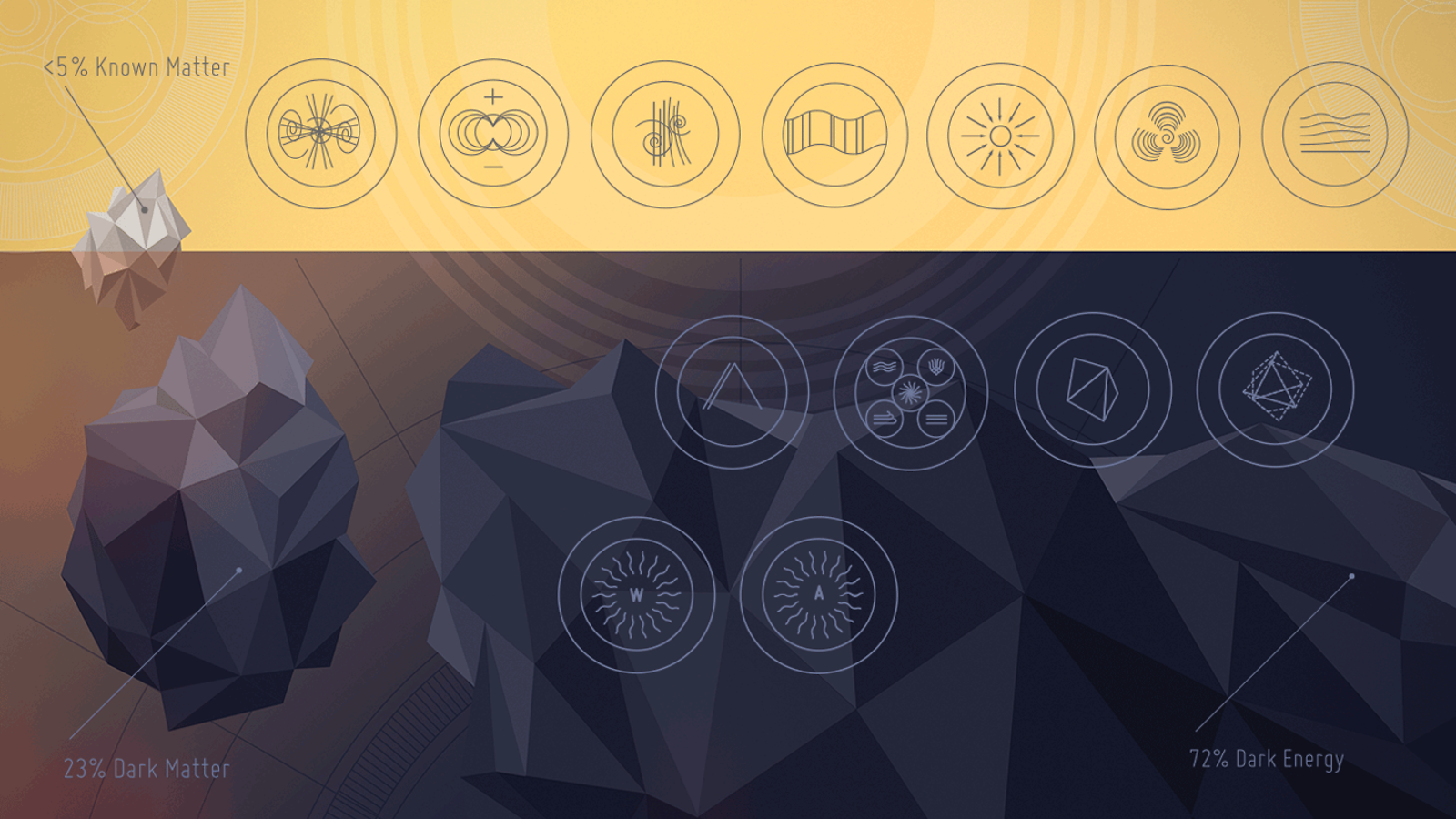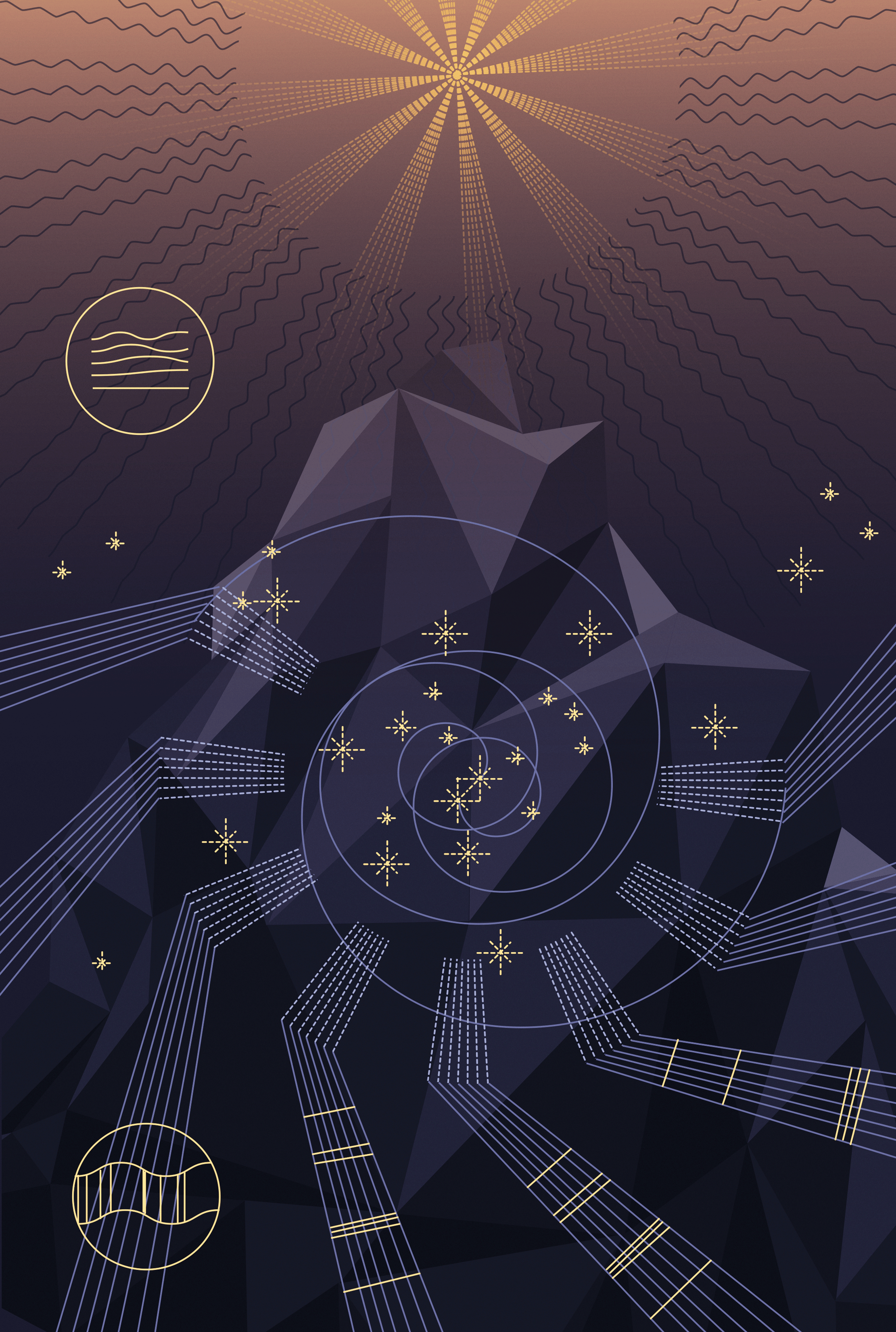If you could use only 5 percent of the alphabet, you’d be stuck with the letter A. Five percent of a complete daily diet is a slice of dry toast.
Yet that’s all we have, or at least all we can perceive, of the place we call home.
Less than 5 percent of the universe is ordinary matter made of quarks, electrons and neutrinos.
The rest is dark matter (23 percent) and dark energy (72 percent). They have nothing in common, it seems, except our inability to see them directly with the tools we have at hand and their profound influence on the visible universe.
Like explorers at the brink of any new frontier, we want to know more. We want to know why galaxies hold together rather than fly apart, why the universe is expanding faster and faster, and how a shadow world of unseen, unexpected particles and/or forces and/or things we can’t even imagine yet could intertwine with our own.
We want to know what this dark stuff is.
In hot pursuit
The pursuit of dark matter and dark energy is one of the most exciting challenges in physics, and it’s being carried out on nearly every conceivable front: deep underground and far out in space, on the vast scale of the cosmos and the infinitesimally tiny scale of subatomic particles, with sound waves from the big bang and the brilliant remains of exploding stars.
Although years of research have yet to reveal the nature of dark matter and dark energy, few scientists doubt they exist; their distinctive fingerprints are all over the cosmos, shaping the growth and evolution of the large-scale structures, such as galactic filaments and clusters, we see today.
Now scientists think they’re beginning to close in.
Theory, observations and sophisticated computer simulations are converging on candidate particles and promising techniques that seem likely, at last, to tell us what dark matter is made of.
“You should be able to see actual dark matter particles just beyond where the current generation of experiments is,” says Glen Crawford, director of the Research and Technology Division of the Office of High Energy Physics at the US Department of Energy, which is a major funder of dark universe projects. “People have been coming up with clever new ways of doing these dark matter experiments.”
As for dark energy, scientists know almost nothing about it at all. But over the next 10 to 15 years, projects now planned or under way will map out the growth and evolution of the universe ever more precisely and further back in time, refining key measurements that offer strong clues to what dark energy is.
Dark matter
The first hint that the dark universe existed came in the 1930s with the realization that there must be much more mass in clusters of galaxies than we can see; otherwise they’d fly apart. This invisible mass is the dark matter.
Although dark matter gives off no light, it does interact with the rest of the universe through gravity, and this gives us a way to find it. The gravitational tug of unseen dark matter bends light coming from faraway objects. By analyzing these distortions, scientists have found clumpy halos of dark matter surrounding many galaxies, including our own. They’ve also found a huge blob of dark matter that separated from normal matter when galaxies in the Bullet Cluster collided.
Not all scientists are convinced that dark matter can account for all this. There is, for instance, a rival theory that contends these observations can be explained by modifying gravity.
But the consensus, for now, is that dark matter is real. And after considering various forms it could take, most of the attention has focused on two candidates: WIMPs and axions.
Enter the WIMP
The WIMP, or Weakly Interacting Massive Particle, is thought to be abundant—by one estimate, a billion of them pass through your body every second—but also shy. The chance that a WIMP will interact with the nucleus of an atom is incredibly small. (Chances are that one per year, at most, will interact with an atomic nucleus inside you.)
But this very weak interaction with ordinary stuff gives scientists a second way, other than gravity, to detect dark matter. They set up detectors made of very dense, ultra-pure material, buried well underground to keep other particles out, and wait for a WIMP to fly through. If and when a WIMP hits the nucleus of one of the atoms in the detector, it will nudge that nucleus just a smidge out of place, producing a flash of heat or light that can be recorded and analyzed. (The WIMP itself goes happily on its way.)
These “direct detection” experiments may have already seen WIMPs.
According to theory, our solar system’s movement through the dark matter halo of our galaxy should produce, from our perspective, “a wind of WIMPs,” says Lauren Hsu, a particle astrophysicist at Fermi National Accelerator Laboratory. The Earth’s yearly orbit around the sun would cause that wind to fluctuate, so that more WIMPs hit detectors in June than in December. That’s the pattern that DAMA/LIBRA, an experiment deep under Italy’s Apennine Mountains, began seeing in the mid-1990s.
However, while two other experiments reported seeing something similar, it was not exactly the same, and others saw no effect. So the jury is still out, and researchers continue to look for ways to understand the DAMA/LIBRA findings.
Today, about a dozen direct-detection experiments are snugged into deep caverns in North America, Europe and Asia. They include the Cryogenic Dark Matter Search in Minnesota’s Soudan Underground Laboratory; XENON100, beneath 5000 feet of rock in Italy’s Gran Sasso National Laboratory; the Large Underground Xenon experiment, beneath the Black Hills of South Dakota; and XMASS, taking data in Japan’s Mozumi Mine.
As scientists continue to ratchet up the detectors’ size, purity and sensitivity, the chance of unequivocally discovering a WIMP is getting better.
“I think this is a special time,” says Laura Baudis, an experimental astroparticle physicist at the University of Zurich, “because we needed more than 10 years, even 15, to develop the technology that was needed in order to test this very low interaction of dark matter with normal matter. Now we have reached, with at least some of the technologies, the level where we can go and build large detectors.”
Meanwhile, scientists have been scanning the skies for indirect signs of WIMPish activity.
According to the prevailing theory, all the WIMPs that ever existed were made in the nanosecond after the big bang. Since then their number has slowly declined, as they decay (quite rarely) into other particles or meet up with their antimatter counterparts and annihilate. Indirect WIMP searches, including the orbiting Fermi Gamma-ray Space Telescope and the PAMELA satellite, look for the results of those decays and annihilations in space, while IceCube and ANTARES look for neutrinos produced by annihilations in the center of the Earth and sun. So far, these searches haven’t found any conclusive confirmation either.
It’s also hoped that WIMPs will show up in particle collisions at CERN’s Large Hadron Collider—not as particles per se, but as a certain amount of energy and momentum that goes missing in particular particle decays.
Aiming for axions
Still other experiments are pursuing axions, another type of dark-matter particle that comes out of a separate set of theories. It is even more weakly interacting than the WIMP and even harder to snag.
“If you had an axion on the table in front of you, it would take 10 to the 50th years to decay. That’s an extraordinary lifetime,” roughly a billion billion billion billion times the age of the universe, says Leslie Rosenberg, principal investigator for the axion-detecting ADMX experiment at the University of Washington. So for a long time people thought it would be impossible to detect the axion by looking for its decay products.
However, in the 1990s, Rosenberg and his colleagues came up with the idea of scaling up a technique that encourages axions to decay by confining them in a very strong magnetic field. Every blue moon, as he puts it, an axion would interact with this magnetic field and produce a detectable photon of microwave light.
It’s a difficult search, but Rosenberg says he thinks an answer is near: “We’re on the cusp of finally being able to have a definitive statement about whether axions make the dark matter.”
A many-pronged approach
Actually, though, there’s no reason why the universe should contain just one kind of dark matter. After all, a lot of different particles make up our measly 5 percent.
“Most studies that have been done have made the simplest assumptions,” says physicist Aaron Roodman of SLAC National Accelerator Laboratory. “But there’s no reason to think dark matter will be simple.”
That’s why scientists are taking so many different approaches to the dark matter search. Each technique has different strengths and weaknesses, and different sources of systematic error. And each one is sensitive to particles of certain masses or characteristics, but not to others.
“No one’s ever going to believe the first signal, even if it’s rock-solid, because it’s such a huge problem,” says Jonathan Feng, a theoretical physicist at the University of California, Irvine. “You need to double-check it, confirm it in as many ways as possible. And exactly how that’s going to go probably depends on what the first signal looks like.”
Dark energy
If dark matter is mysterious, dark energy is even more so. No one had a clue it was out there until the late 1990s, when observations of supernovae—exploding stars that shine 5 billion times brighter than the sun—showed that the expansion of the universe is accelerating. Something is pushing the cosmos outward, counteracting the force of gravity—an observation that earned three American scientists the 2011 Nobel Prize in physics.
What is this something? No one knows. It could be Einstein’s cosmological constant, another way of saying that “there is a mass, a density, to completely empty space—that space weighs something,” as cosmologist Rocky Kolb of the University of Chicago puts it.
Another possibility is that dark energy is a field—perhaps a fluctuating field known as quintessence, named in allusion to a classic “fifth element” proposed by the ancient Greeks, or something like the Higgs field that imparts mass to other particles.
While scientists haven’t thought of a way to detect dark energy directly, they do have a rough consensus about where to look for its influence on the shape of the universe and on the methods most likely to expose its character.
“At the moment our only measurement of dark energy is what it has done to the expansion of the universe,” says cosmologist David Schlegel of Lawrence Berkeley National Laboratory. “We’re measuring what there is to measure, basically.”
To make these measurements, scientists use a combination of techniques to make detailed images of the cosmos, translate those images into 3D maps and figure out how fast big, bright objects are moving away from us—and thus how fast the universe was expanding at specific points in its history.
They have three handy yardsticks for measuring these faraway distances and speeds.
One is exploding stars—specifically Type Ia supernovae, which all give off about the same amount of light when they explode. The farther away they are, the fainter they appear, so they serve as unique markers on the cosmic distance scale. Tracking their movements led to the discovery of dark energy, and, as scientists find and track more of them, they are refining the story these stellar explosions tell.
A second is to study the clumping of matter in the universe, the so-called “growth of structure.” Scientists can infer how the universe has expanded by measuring the number of galaxy clusters with different masses and at different times. And the distribution of all mass in the universe can be studied by detecting the bending of the light from distant galaxies by all matter, dark or otherwise, between them and us.
The third is “baryon acoustic oscillation,” patterns of frozen sound waves left over from the big bang. These patterns help determine the average separation between galaxies, which increases as the universe expands and serves as another cosmic ruler.
All of these methods use spectroscopy—breaking the light from distant objects into a rainbow of colors for analysis. When an object is moving away from us, its light is shifted down toward the red end of the spectrum, just as a train’s whistle shifts to a lower tone as it chugs away. This redshift tells us how fast the object is moving as the cosmic expansion carries it away.
From what they’ve learned so far, scientists think this is what happened: For the first few billion years after the big bang, emerging galaxies and other clumps of matter were so close together that their combined gravitational pull slowed the expansion of the universe. But by about 5 billion years ago, the galaxies had dispersed enough that dark energy—which had been a constant, repulsive force all along—won out over this gravitational drag, and the expansion began to accelerate.
Seeking the invisible
In November 2012, the Baryon Oscillation Spectroscopic Survey, part of the larger Sloan Digital Sky Survey, released the first measurement of how fast the cosmos was expanding before this transition occurred, 3 billion years after the big bang.
Another major project, the Dark Energy Survey, will start mapping the universe in 2013 from a telescope perched on a Chilean mountaintop. It aims to chart the expansion of the universe and the growth of large-scale cosmic structures back 14 billion years.
And in Texas, scientists are upgrading the McDonald Observatory’s Hobby-Eberly Telescope to carry out a dark-energy experiment called HETDEX, which has a goal of measuring the positions and movements of 1 million galaxies starting in 2014.
Meanwhile, scientists are preparing a new generation of dark-energy projects to attack the problem from the ground and in space.
In the relatively near term, the US Department of Energy has declared a need for an advanced spectroscopic survey, and scientists are drawing up a proposal for one.
Longer term, the Large Synoptic Survey Telescope, which should begin construction in Chile next year, will use the world’s largest digital camera to create the deepest, widest and fastest portrait of the night sky ever made from the ground. The resulting data—an unprecedented 6 million gigabytes per year—will shed light on both dark matter and dark energy.
And in Europe, scientists recently received approval to build a billion-dollar space telescope, Euclid, to study the expansion of the universe, with an eye to understanding dark energy and dark matter. NASA joined the mission in early 2013.
The ever-more-precise measurement of cosmic structure and expansion should eventually allow scientists to determine what’s called the “equation of state”—the ratio of pressure to density—of the dark energy itself, Roodman says. If the dark energy is Einstein’s cosmological constant and it has remained steady over time, that ratio should be close to minus 1; weirdly, this would mean it had negative pressure. If it has a different value, scientists will know that the dark energy is something else.
The path ahead
Scientists are confident that the experiments under way and those now under construction will bring us significantly closer to understanding the dark universe around us. But in particle physics, planning the next experiments—and developing the technologies that make those experiments possible—takes decades.
In August, hundreds of scientists will meet in Minnesota for what is known as the Snowmass Meeting—a once-a-decade gathering to identify the most important and pressing questions in particle physics and the experiments the United States should pursue to answer them. The meeting will cover all aspects of the field, from experiments that smash particles together at very high energies and intensities to detectors and other instruments, theory, computing and public outreach.
Dark matter and dark energy will be major items on the agenda. And while the meeting is not designed to set formal priorities, researchers hope to reach consensus on the next generation of approaches and projects to probe the dark universe from a number of complementary angles and with the funding realistically available.
“Are there clever little things that can be done to push the envelope without breaking the bank?” asks Feng, who is co-organizing the part of the meeting that covers dark energy and dark matter. “There are a lot of questions about how to design a national program that covers as many bases as possible within the budget.”
One thing seems certain: The dark universe offers some of the most compelling science imaginable. “It’s the area where we know the least, so it’s a natural place to look for discoveries,” Roodman says. “I think in most cases the science should be quite rich, in the sense that when you answer some questions, there will be other questions to ask. This is, I think, where a lot of the next discoveries will come from.”
Editor's note: Since this article was first published, it has been updated to include NASA's decision to join the Euclid mission.

















